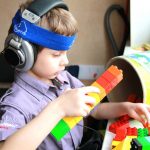Shane is sitting in his classroom, and the teacher is explaining a new math problem and the steps to solving it. He loves math and is really trying to listen. He looks away out of the window to other kids playing outside while he keeps listening to the teacher. His teacher notices this and requests of him to look at her as she is explaining this more complicated issue. Shane knows he has to look at his teacher, though finds it really difficult to do and after a while, he starts to fidget and move around in his chair and gains another comment from his teacher to stop fidgeting. As far as the teacher is concerned, Shane must have ADHD. He always appears distracted and constantly has to fidget in his seat. For Shane it is a whole other story.
There are so many different reasons why this scenario could be playing out before we need to consider such strong diagnosis such as ADHD or ADD. I will cover these differential diagnostics according to the hierarchy of development. First, it could simply be that Shane has not integrated attentive primitive reflexes such as the ATNR (Asymmetrical Tonic neck Reflex) or STNR (Symmetrical Tonic Neck reflex) or others, and the seated position causes discomfort because of this.
Secondly, it could be that Shane does not have sufficient balance between his postural extension and flexion in order to maintain this seated position for prolonged periods of time. A third option could be that there may be a processing speed delay in either his visual or auditory system, causing him to prefer the stronger of both in order to capture some of the instruction. Or it could be that he is not able to time the visual and auditory instruction together in his brain, causing him to need to look away so at least he can use one channel of information.
Because sensory processing, reflexes, postural control does not carry an official medical diagnosis in the DSM, doctors feel obligated to place him in some category and ADHD appears to be a good fit.
His teacher feels rightly so that a further step needs to be taken in getting Shane in a better position to learn from the teaching environment. So she suggests that his parent and herself complete a Connor’s rating scale and sure enough, Shane is considered at risk for ADHD and the notion of stimulant medication is discussed. Everyone has his best interests at heart, but what if this is not the right route and that chemical intervention might not be what he needs at all? Truth is that if I answer the questions on a Connor’s rating scale and compare with the answers I get from completing a Sensory Profile, we will also find a sensory explanation to the very same questions. Because sensory processing, reflexes, postural control does not carry an official medical diagnosis in the DSM, doctors feel obligated to place him in some category and ADHD appears to be a good fit.
But what if the teacher referred him to occupational and / physical therapy? And we discover that the underlying building blocks are not in place for him and that rather than seeing him as a “behavior issue”, we discover he is really trying hard with what he has? Shane has no other body to compare himself to. He has no sense of comparison what it may feel like for his peers. All he knows is what he sees. They appear to cope fine; therefore he has to find a way. He compensates, he copes through cognition and long term memory, he tries it all, but as the grades and performance demands increases, his coping strategies become less effective and soon other behaviors start, impulsivity and daydreaming increases. It is not willful, but rather an outflow of a boy who is not in charge of his system, but does not know why.
As professionals we have to support families in “chasing the why” before simply accepting the most obvious route. Human behavior has never been obvious, the subtleties are multiple and we have to address issues at their root cause in order to be the most effective clinicians for every child coming through our door.
One last thought is that anxiety could be another factor that can look exactly like an attention profile. I am doing a webinar on this on May 22, 2017. E-mail me at maude@atotalapproach.com if you are interested.








